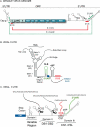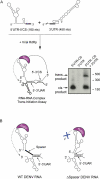Functional RNA elements in the dengue virus genome
- PMID: 21994804
- PMCID: PMC3187688
- DOI: 10.3390/v3091739
Functional RNA elements in the dengue virus genome
Abstract
Dengue virus (DENV) genome amplification is a process that involves the viral RNA, cellular and viral proteins, and a complex architecture of cellular membranes. The viral RNA is not a passive template during this process; it plays an active role providing RNA signals that act as promoters, enhancers and/or silencers of the replication process. RNA elements that modulate RNA replication were found at the 5' and 3' UTRs and within the viral coding sequence. The promoter for DENV RNA synthesis is a large stem loop structure located at the 5' end of the genome. This structure specifically interacts with the viral polymerase NS5 and promotes RNA synthesis at the 3' end of a circularized genome. The circular conformation of the viral genome is mediated by long range RNA-RNA interactions that span thousands of nucleotides. Recent studies have provided new information about the requirement of alternative, mutually exclusive, structures in the viral RNA, highlighting the idea that the viral genome is flexible and exists in different conformations. In this article, we describe elements in the promoter SLA and other RNA signals involved in NS5 polymerase binding and activity, and provide new ideas of how dynamic secondary and tertiary structures of the viral RNA participate in the viral life cycle.
Keywords: NS5 protein; RNA structures; dengue virus; flavivirus RNA; genome cyclization; viral RNA replication; viral RdRp.
Figures




Similar articles
-
Interplay of RNA elements in the dengue virus 5' and 3' ends required for viral RNA replication.J Virol. 2010 Jun;84(12):6103-18. doi: 10.1128/JVI.02042-09. Epub 2010 Mar 31. J Virol. 2010. PMID: 20357095 Free PMC article.
-
Interactions between the Dengue Virus Polymerase NS5 and Stem-Loop A.J Virol. 2017 May 12;91(11):e00047-17. doi: 10.1128/JVI.00047-17. Print 2017 Jun 1. J Virol. 2017. PMID: 28356528 Free PMC article.
-
RNA sequences and structures required for the recruitment and activity of the dengue virus polymerase.J Biol Chem. 2011 Mar 4;286(9):6929-39. doi: 10.1074/jbc.M110.162289. Epub 2010 Dec 23. J Biol Chem. 2011. PMID: 21183683 Free PMC article.
-
The Transactions of NS3 and NS5 in Flaviviral RNA Replication.Adv Exp Med Biol. 2018;1062:147-163. doi: 10.1007/978-981-10-8727-1_11. Adv Exp Med Biol. 2018. PMID: 29845531 Review.
-
Flavivirus RNA-Dependent RNA Polymerase Interacts with Genome UTRs and Viral Proteins to Facilitate Flavivirus RNA Replication.Viruses. 2019 Oct 10;11(10):929. doi: 10.3390/v11100929. Viruses. 2019. PMID: 31658680 Free PMC article. Review.
Cited by
-
Cytoplasmic translocation of polypyrimidine tract-binding protein and its binding to viral RNA during Japanese encephalitis virus infection inhibits virus replication.PLoS One. 2014 Dec 29;9(12):e114931. doi: 10.1371/journal.pone.0114931. eCollection 2014. PLoS One. 2014. PMID: 25545659 Free PMC article.
-
Reprint of: Core protein-mediated 5'-3' annealing of the West Nile virus genomic RNA in vitro.Virus Res. 2012 Nov;169(2):448-57. doi: 10.1016/j.virusres.2012.09.009. Epub 2012 Sep 27. Virus Res. 2012. PMID: 23022255 Free PMC article.
-
Molecular characterization and phylogenetic analysis of a dengue virus serotype 3 isolated from a Chinese traveler returned from Laos.Virol J. 2018 Jul 24;15(1):113. doi: 10.1186/s12985-018-1016-5. Virol J. 2018. PMID: 30041666 Free PMC article.
-
AUF1 p45 promotes West Nile virus replication by an RNA chaperone activity that supports cyclization of the viral genome.J Virol. 2014 Oct;88(19):11586-99. doi: 10.1128/JVI.01283-14. Epub 2014 Jul 30. J Virol. 2014. PMID: 25078689 Free PMC article.
-
Detection of Dengue Virus-Specific IgM and IgG Antibodies through Peptide Sequences of Envelope and NS1 Proteins for Serological Identification.J Immunol Res. 2020 Aug 4;2020:1820325. doi: 10.1155/2020/1820325. eCollection 2020. J Immunol Res. 2020. PMID: 32832567 Free PMC article.
References
-
- Lindenbach BD, Rice CM. Fields Virology. Vol. 1. Lippincott-Raven; Philadelphia, PA, USA: 2007. Flaviviridae: The viruses and their replication; pp. 1101–1152.
-
- Rice CM, Lenches EM, Eddy SR, Shin SJ, Sheets RL, Strauss JH. Nucleotide sequence of yellow fever virus: Implications for flavivirus gene expression and evolution. Science. 1985;229:726–733. - PubMed
-
- Westaway EG, Mackenzie JM, Khromykh AA. Kunjin RNA replication and applications of Kunjin replicons. Adv Virus Res. 2003;59:99–140. - PubMed
Publication types
MeSH terms
Substances
Grants and funding
LinkOut - more resources
Full Text Sources
Other Literature Sources
Medical
Research Materials

